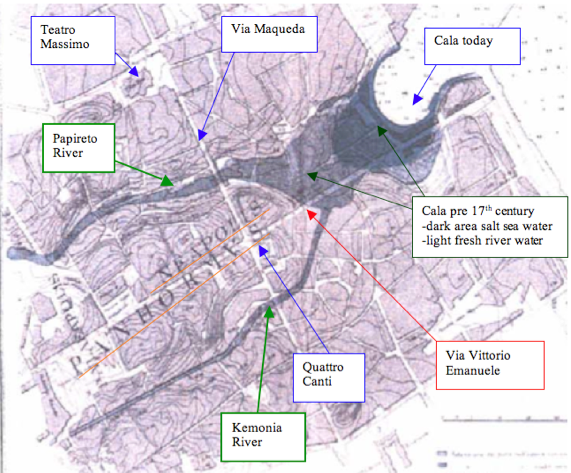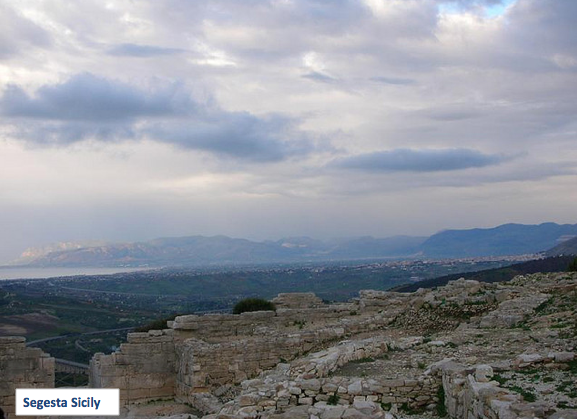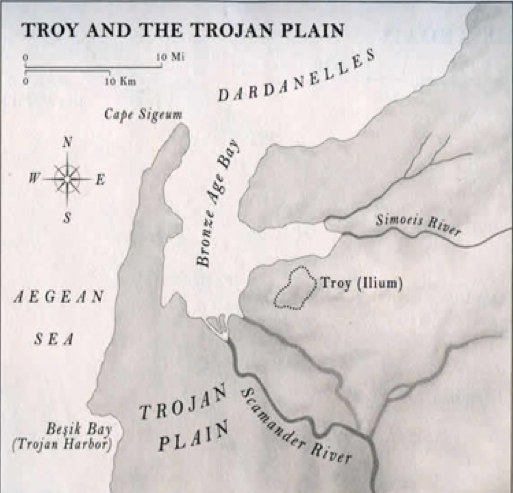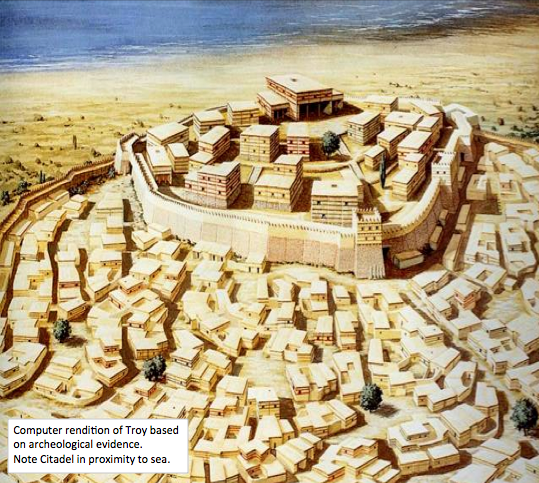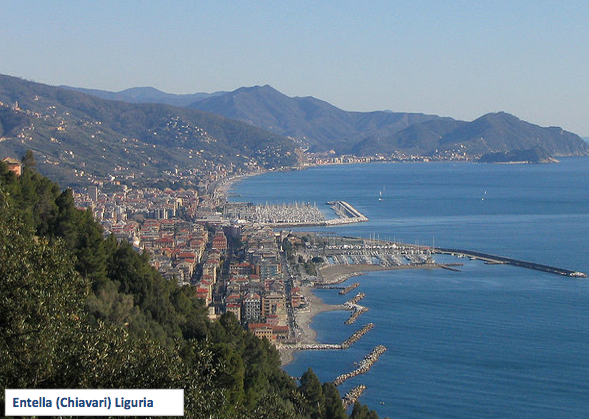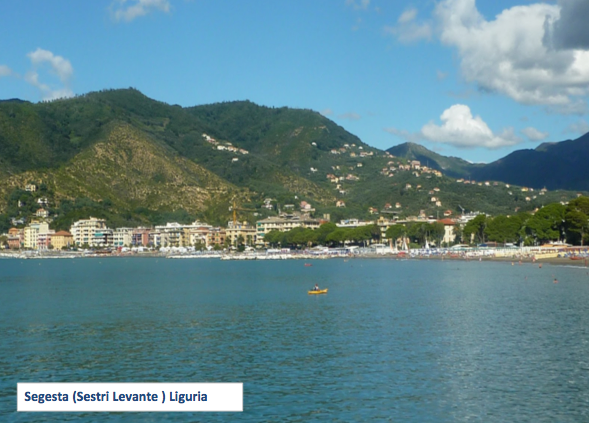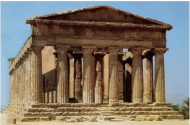Preface
Any study of ancient Sicilian history must from the onset include the seminal and incredible scholarly work of the great classical scholar Edward A. Freeman: The History of Sicily – From The Earliest Times (1891).
The following is drawn in large part from Professor Freeman’s book. However, it seems to me, Freeman by limiting his evidence base solely to ancient documentary evidence (as would be expected from a nineteenth century Critical Method historian), and not taking into consideration some archeological and geographic evidence, limited the range of possible inferences about the Elymain Sicilians.
Significant evidence in the form of similar geographic characteristics of:
- Troy (where the ancients universally agree the Elymians came from),
- Elymian cities in Sicily,
- Ligurian and Roman settlements circa 1000 – 750 BC
when contextualized along with ancient source documentary evidence provides a more comprehensive (albeit still very speculative) picture of the Sicilians Freeman rightfully characterized as “Mysterious.”
This is not to say or imply that I presume to improve on the work of a great classical scholar. Rather, to point out some interesting facts and correlations that one might want to take into consideration when delving into the history of La Mysteriosa Sicilia
Introduction
Before the Greek and Phoenician colonizers arrive in Sicily circa 750 B.C., there were three district groups of people who came before them. Freeman writes:
“Every ancient writer who undertakes to give a view of Sicilian history begins by a list of the nations which were already dwelling in the island when the Phoenician and Greek settlement began.” (p. 99)
Those pre-Phoenician/Greek “nations” were the Sicels, Sicani and Elymians.
[Note: It is not uncommon to read characterizations of these three people as “indigenous” (or words to that effect) at the time the Greeks and Phoenicians arrived.
However, they were not in any sense “native” in the sense of “Native Americans” when the European colonist arrived. The Sicels, Sicani and Elymians were themselves colonist who came from other places not long before (perhaps a few centuries) the Greeks and Phoenicians.]
Much more is know about the Sicels and Sicani than Elymians. There are remnants of the Sicels and Sicani Latin language and volumes of Greek documents describing their society. However, the Elymian language is lost and there is much less recorded about them in Greek documents. Freeman:
“The little that we know of Sikans and Sikels is strictly traditional; that is it comes from a source trustworthy in is own nature, though not a little liable to be corrupted.
The origin of the Elymians comes within the range of legend, and that kind of legend which always savours of deliberate invention. (p. 195)
However, what little is known about the Elymians is intellectually provocative and stimulating for historians with a detective’s bent. Due to the lack of documentary evidence, the study of Elymians must draw heavily on material evidence. Historical geography is an important tool in the historiography of Elymian history. (see map below)
Elymian Sicilian Homeland
Elymian Cities (brown circles on map)
There are two locations of ancient Elymian cities that are not disputable:
Eryx (modern Erice; mountain top adjacent to modern Trapani)
Segesta (same modern name)
The city of Entella (left bank of the modern Belice River about 25 miles from the mouth of the Belice) is disputed to be either Elymian or Sicani.
The significance of the ethnicity of Entella will be discussed below in terms of inferences about Sicilian colonists in Liguria.
Regions (solid blue line OR dotted red line on map)
Accordingly, because of there is no agreement about the status of Entella, the general territorial region under Elymian control (indicted on the map respectively with solid blue line or dash red line) will vary depending on the status of Entella being either Elymian or Sicani (see 'textbox' notes on map).
Neighbors ('textbox' notes on map)
It is significant that in either case (blue line or red), various other national groups surround the Elymian territory:
Phoenicians to the North (Palermo) and Southwest (Mozia)
Greeks to the South (Selinunte)
Sicani town to the North (Hyccare/Carini) and territory to the West
The significance of this surrounding territorial configuration will be discussed below in terms of inferences about Elymian colonists in Liguria and possibly the founding of Rome.
Entella (Elymian: “to be or not to be”)
Freeman categorically and emphatically rejects Entella as an Elymian location. He writes:
“Entella: The hill fortress by the eastern branch of the Hypsas or Belice [river], which is to this day know in a marked way as the Rock of Entella stands apart from both the known Elymian settlements [Eryx & Segesta], in a land thoroughly Sikan. Its territory may well have bordered on that of Segesta, but that is all. A hill-town without a haven [seaport], even a haven as distant as that of Segesta, it bears the stamp of the most primitive occupations.” (p. 122)
Freeman presents an incredibly comprehensive ancient source document analysis substantiating his argument that Entella was Sican and not Elymian. However, in a noteworthy demonstration of objective scholarship, he also indicates that there are both ancients and modern commentators who differ with his conclusion. He writes:
“What was the number of the Elymian settlements? Thucydides mentions Segesta and Eryx only…But it is quite clear that some of the later [ancient] writers looked on Entella as an Elymian foundation, and some modern scholars have adopted the same view…Holm and Busolt accept Entella as Elymian.” (p. 552)
As noted above, Freeman’s argument is based solely (so far as I understand him) on a meticulous analysis of ancient source documents. However, it seems to me that he fails to at least consider the fact of Ligurian settlements with identical place names as those in Elymian Sicily and the inferences that fact may have for conclusions about Entella being Elymian or not. He writes:
“When Holm finds the names Eryx, Entella, Segesta itself, repeated in Liguria…I do not draw from it any inferences…I look on the names rather as traces of the general pre-Aryan occupation…” (p. 554)
Sicilians in Liguria – Common Place Names
Three outstanding classical scholars, the German Adolph Holm in 1870, the Italian in Ettore Pais in 1908, and the English Toynbee in 1932, noted the presence of three Sicilian place names in Liguria: Eryx [modern Lerici], Segesta [modern Sestri Levante] and Entella [near modern Chiavari Entella river]. Moreover, unlike Freeman who ignored them as insignificant similarities, they considered what the common names might imply about Elymian history.
Most significantly, to my mind, Toynbee posits that a linguistic characteristic of the word 'Eryx' clearly implies that colonizing Elymians from Sicily created the Ligurian settlements. He writes:
“The probability that the group of names in Liguria was derived from the group in Sicily is indicated by the fact that in Liguria, as in Sicily, the mountain-name appears in the Graecized form ‘Eryx’ and not in a Ligurian equivalent ... ‘verruca’ (‘peak’), which we should expect to find surviving here if the name had originated in Liguria and had been carried thence to Sicily.” (A Study of History v.8 p.705 emp.+)
In short, the Elymian language in Sicily showed the influence of the Greek language as the Greeks and Elymains interacted with each other. Accordingly, there is no other probable way to explain a mountain in Liguria with a ‘Elymian-Greek’ name Eryx.
[Note: Pais in his book (Ancient Italy: Historical and Geographical Investigations in Central Italy, Magna Graecia, Sicily, and Sardinia) discusses in detail the linguistics of the common Ligurian/Elymain place names (p. 111-115). However, it is a very technical linguistic presentation that I don’t completely understand. There seems to be some agreement with Toynbee but there may also be some differences.
A teacher in a rigorously historiographic course on the ancient history of Sicily would, it seems to me, be obliged to guide the students through Pais’ very challenging text.
Nevertheless, Toynbee and Pais, unlike Freeman, agree that the commonality of names in Sicily and Liguria is not just coincident even if they may differ about the implications.]
Thus: If Toynbee is correct (i.e. Elymains colonized Liguria), then (a fortiori) Entella Sicily was likely Elymian. Specifically:
If Freeman is correct and Entella Sicily is Sican
then the implication is that
both Elymians and Sicani colonized Liguria: Elymains at Eryx and Segesta, and Sicani at Entella.
In table form:
|
If Freeman is correct
|
|
Then Two colonial groups
|
|
|
|
|
|
|
|
Sicily Location
|
Ethnic Group
|
|
Liguria
Location
|
Ethnic Group
|
|
Eryx
|
Elymian
|
|
Eryx
|
Elymian
|
|
Segesta
|
Elymian
|
|
Segesta
|
Elymian
|
|
Entella
|
Sican
|
|
Entella
|
Sican
|
If Freeman is incorrect (i.e. Entella Sicily is an Elymian city)
then the implication is that
only the Elymians colonized Liguria.
In table form:
|
If Freeman is Not correct
|
|
Then One colonial group
|
|
|
|
|
|
|
|
Sicily Location
|
Ethnic Group
|
|
Liguria
Location
|
Ethnic Group
|
|
Eryx
|
Elymian
|
|
Eryx
|
Elymian
|
|
Segesta
|
Elymian
|
|
Segesta
|
Elymian
|
|
Entella
|
Elymian
|
|
Entella
|
Elymian
|
Subjectively: It seems to me a low probability that two different Sicilian national groups would colonize the same general area in proximity to one another in Liguria (think England and Spain in the Americas).
This is to say: that it seems much more likely that Elymians from the three Sicilian sites colonized Liguria; thus, to my mind, Entella Sicily was likely Elymian.
Elymians in Sicily – No Seaport Cities
If one knew nothing else about the Elymians than the locations of their Sicilian cities, there would be no doubt that the occupants of those cities were a very different people than the Phoenicians and the Greeks.
Freeman writes:
"Little as we know of the mysterious race [i.e. Eymians] that held Segesta, we know at least what manner of sites they chose for their cities...They are not such as either the Phoenician or the Greek would have chosen.
The Elymian settlers had clearly not learned to love the sea. Of their two sites neither is on the sea-shore. Both indeed stand within sight of the sea; one of them [Eryx] is very near to it; both in after times made havens [seaports] on the shore; but we may doubt whether they had havens from the beginning. We may suspect that Drepana [Trapani] did not become the haven of Eryx till ages after Eryx, town and temple, had come into being. (p. 200)
To fully appreciate the difference between Phoenician and Greek cites vs. Elymian that Freeman is talking about; consider the map below which overlays the river/port system of Phoenician Palermo on to a modern street map.
Clearly, this is a seaport city designed to provide a safe harbor and easy access to the sea for ships. [Note: for a detail discussion of the history of Palermo rivers and port see: “Palermo: Ancient Rivers and Modern Streets”… http://www.i-italy.org/bloggers/15886/palermo-ancient-rivers-and-modern-streets]
Now compare Palermo with the location of Elymian Eryx at the top of a mountain. Below is the view of the location of the ancient city looking up from the Trapani coast. Notice, as Freeman points out, that the mountain top city was in close proximity to the sea but most definitely not a seaport city.
Similarly Segesta the other Elymian city is about six miles inland, but the sea (Castellamare del Golfo) can be seen from its mountain location (image below).
Entella
Because the two known Elymian cities (Eryx and Segesta) are in close proximity to the sea, and Entella is approximately twenty-five miles inland, Freeman concludes that Entella is not Elymian. However, it seems to me that one has to consider the fact that Entella is on the Belice River which flows out to the Mediterranean. Thus, Entella was an inland city but not a ‘land-locked’ city; indeed, the access to the sea by river may have been easier than the six mile walk to the sea from Segesta.
In short, the two (or three) Elymian cities in Sicily were Not seaport cities and were located on mountains in proximity to the sea or with access to the sea by river.
Accordingly, when presented with other cities with similar geographic characteristics, the question comes to mind: are they ALSO Elymian cities?
Elymian Sicilian Citadel Locations … implications about Troy, Liguria and Rome
Trojan Origins
Freeman writes:
“The Trojan origin of the Elymians is asserted or assumed by nearly all ancient writers who speak of the matter.” (p. 542)
Again, Freeman does not find this credible based on meticulous document analysis. However, again, I think his analysis may have been two narrow in that he was not open to two facts (document and geography), which would render at least possible the Trojan origins of the Elymians.
First, Freeman does not seem to appreciate the implications of his own documentary evidence.
“The Elymians in the north-west corner of Sicily [were] a people whom the Greek writers set down as barbarians along with Sikans and Sikels, but who had traditions, or at least pretensions, which brought them nearer to the Hellenic range (p101)
Note: “Barbariani is a term use by the Greeks to denote “all non-Greeks” (http://www.etymonline.com/index.php?term=barbarian). However, not all Barbarians were the same.
Thus, Freeman writes:
“The Elymians were, in the Greek sense, barbarians…But, they are barbarians that stand alone. (p. 197-198)
What does it mean to say:
"Elymians were barbarians...but...traditions nearer to Hellenic"?
Freeman writes:
“Thucydides tells us that the people of Segesta were Elymian, and that the Elymians were barbarians; but neither in his narrative nor in any other [i.e. narratives by other Greeks] are they [Elymians ] systematically marked of as in the way in which both Phoenicians and Sikels are marked off.”
“Segesta is constantly spoken of along with the Greek cities, Selinous or any other, in matters of war and peace, without any hint that she was not a Greek city like the rest. A war with Segesta, a treaty with Segesta, is hardly ever spoken of as a war or a treaty with barbarians.” (p.203)
Thus, Phoenicians, Sekels and Elymians were classified (characterized) as barbarians (non-Greeks). But, the Elmians were thought of as a different kind (type) of barbarian.
It seems to me that this Greek attitude towards the Elymians is analogous to the Greek attitude towards the Trojans.
Troy was not a Greek city but was clearly associated with Greek culture (above:"traditons nearer to Hellenic") as evidenced by the fact that in the Iliad some Greek gods and goddess helped the Trojans (e.g. Aries and Artemis).
Accordingly, the ancient documents positing the idea that the Elymians were some sort of refugees from Troy have to be given some credence.
Second, Freeman again ignores geographic evidence. Above it is noted that the Elymian cities were not seaport cities, and were citadels in proximity to the sea. Archeologists have demonstrated that was exactly the characteristic of Troy. See for example, the map below of a reconstruction of the Bronze Age seacoast setting of Troy.
(http://www.cwu.edu/~garrison/images/trojan_plain.jpg)
Also, consider the computer rendition of Troy based on archeological data.
Clearly, the map and graphic of Troy indicates a citadel city in proximity to the sea. I submit that the map and geographic reproductions of Troy as a non-seaport citadel city in proximity to the sea is almost an exact match of Eryx and Segesta.
In sum, the probability that the Elymians were of Trojan origin is not insignificant based on the following facts:
1. Ancient documents stipulate they were Trojans
2. The Greeks held them to be a special category of barbarian as they did the Trojans
3. The geographic characteristics of Elymian cities Erxy and Segesta are identical to Troy
Liguria
As discussed above, evidence that Elymians from Sicily colonized Liguria takes the form of ‘common place name’ and Grecized word for mountain.
Also, it should be noted that the Ligurian settlements were geographically identical to the Sicilian cities of Eryx and Segesta (and Troy) – a citadel in proximity to the sea.
See pictures:
[Note: these modern day pictures are not meant to suggest that they are the exact locations of the Sicilian settlements in Liguria. I'm not sure if archeological remnants of those sites have been found. Rather, the pictures indicate the approximate locations of the Elymian settlements in Liguria as described in ancient documents. The pictures also indicate that the Elymian Sicilians were locating their settlements in geographic areas similar to those in Sicily.]
Political Geography
Another reason to give credence to the idea that Elymians colonizing Liguria is the similar political geography of Elymian Sicily and Liguria. As noted above, the Elymian land in Sicily was inserted between foreign nations; the Greeks on the south and the Phoenicians on the north and the Sicani in the east.
Similarly, the Ligurian settlements were between foreign people. Toynbee writes:
“The Elymains choose a place to colonize on the Italian Riviera between the north-western outpost of the Etruscans and the eastern outposts of the Massiliots.” (v. 8 p. 705)
Rome
The specifics of Toynbee’s argument that the origin of the city of Rome may have been a Sicilian settlement are discussed in detail in the linked articles below.
For present purposes, I would note the similarity of the physical and political geography of original Rome: Citadel (Alban Hills) with access to the sea (on the Tiber River down to Ostia; similar to Entella Sicily) and inserted between the Etruscans on the north and Greeks (Magna Graecia) on the south.
Also, the ancient legend of Rome being founded by Trojans who came to Italy via Sicily - Eryx (no less)! For example, Virgil's Aeneid:
‘Brave Aeneas, I would not expect to make Italy
with this sky, though guardian Jupiter promised it.
The winds, rising from the darkened west, have shifted
and roar across our path, and the air thickens for a storm.
We cannot stand against it, or labour enough to weather it.
Since Fortune overcomes us, let’s go with her,
and set our course wherever she calls. I think your brother Eryx’s
friendly shores are not far off, and the harbours of Sicily (Book V)
The Trojan Aeneas has a brother named Eryx located at a harbor in Sicily.
Interesting...No?
In conclusion
Nothing in the above presentation is meant in any way as proof of any facts of Sicilian history. Rather, to indicate that a close analytical reading of the facts as they are presented by competent classical scholars coupled with the methods of historical geography clearly indicate ancient Sicily was a profoundly complex and intellectually stimulating society with profound implications for the history of the Sicilian people, the people of Italy and the whole of Europe.
That so much scholarly and teaching effort is devoted to that small tab of history called Renaissance and so little to Sicily is fascinating; especially in a country with millions of Sicilian descendants and virtually none from the Arno Valley.
Daydreaming … a someday university South of Rome Studies Program: the curriculum in such a program would include a course offered by a master teacher who would guide students through the comprehensive source document narratives, the geographic history and ideologies of the ancients. The intention of such a course would not be to simply learn about ancient Sicily, but perhaps more importantly to learn the concepts, methods and techniques of the “Historian’s Craft”.
..........
Bibliographic links
Sicilian Origins of Rome
“Sicilian Lights on Roman Origins”
http://www.i-italy.org/bloggers/1225/sicilian-lights-roman-origins
February 9, 2008
Science, Irony and Italian History - a “Southern Question” twist!
http://www.i-italy.org/bloggers/10391/science-irony-and-italian-history-southern-question-twist
August 9, 2009
Sicilian Founders of Rome (revisited...again) – The Logic of Historiography (wonkish: hate philosophy?...forget-about-it!)
http://www.i-italy.org/bloggers/19841/sicilian-founders-rome-revisited-again-logic-historiography-wonkish-hate-philosophy-f
Sicilian Odyssey
Step Aside Homer! "The Authoress of the Odyssey” is a Sicilian Girl from Trapani
http://www.i-italy.org/bloggers/35865/step-aside-homer-authoress-odyssey-sicilian-girl-trapani
April 23, 2013
“Odyssey” ‘Song of Sicily’… Poet’s Images = Sicilian Reality
http://www.i-italy.org/bloggers/35917/odyssey-song-sicily-poet-s-images-sicilian-reality
April 29, 2013
“Odyssey” – Women of Greece vs. the Women of Sicily
http://www.i-italy.org/bloggers/36014/odyssey-women-greece-vs-women-sicily
May 14, 2013


